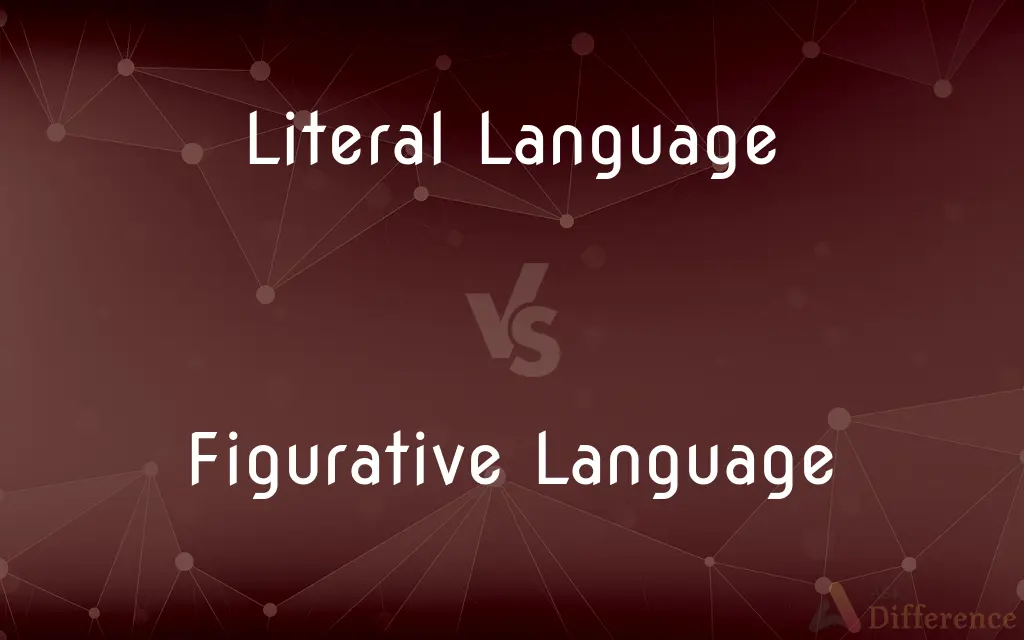Literal Language vs. Figurative Language — What's the Difference?
Edited by Tayyaba Rehman — By Fiza Rafique — Published on December 4, 2023
Literal Language conveys words' exact meanings, while Figurative Language employs metaphors, similes, and other devices for artistic or emphatic effect.

Difference Between Literal Language and Figurative Language
Table of Contents
ADVERTISEMENT
Key Differences
Literal Language, as the name implies, refers to language that adheres to the exact, defined meaning of words. When someone uses Literal Language, they aim to be precise, clear, and straightforward in their communication. Figurative Language, on the contrary, taps into creative expressions that go beyond words' dictionary definitions. By leveraging figures of speech, Figurative Language often imparts deeper or alternative meanings.
In daily conversations, Literal Language plays a crucial role in avoiding misunderstandings. If someone says, "I have two dogs," using Literal Language, the listener can confidently infer the speaker owns exactly two dogs. Figurative Language, though, would allow the same sentence to be interpreted in various ways, depending on the context and the figure of speech applied. For instance, "dogs" might refer metaphorically to two problematic issues the speaker is dealing with.
Literal Language predominantly finds its application in formal communications, technical writings, and academic contexts where clarity is paramount. The straightforward nature of Literal Language ensures that information is presented without ambiguity. Conversely, Figurative Language is abundant in literature, poetry, and everyday expressions where emotional resonance, imagery, or emphasis is desired. By saying "My love is a red rose," a poet employs Figurative Language to draw parallels between love and the qualities of a rose.
Moreover, Literal Language remains consistent in its interpretation across different contexts. A statement made using Literal Language retains its meaning unless the definitions of the words within it change. Figurative Language, on the other hand, can be open to interpretation. The statement "He has a lion's heart" using Figurative Language can suggest courage, but depending on context, it could imply other attributes associated with lions.
In essence, while Literal Language prioritizes directness and clarity, Figurative Language embraces nuances, emotions, and imagery, adding layers of meaning to communication.
ADVERTISEMENT
Comparison Chart
Meaning
Adheres to exact definitions of words
Uses creative expressions beyond literal meanings
Usage
Formal communications, technical writings
Literature, poetry, everyday expressions
Interpretation
Consistent and clear
Can vary based on context and figure of speech
Purpose
Convey precise information
Impart deeper/emotional meaning, imagery, emphasis
Examples
"She bought a blue car."
"Her voice is music to his ears."
Compare with Definitions
Literal Language
Literal Language avoids figures of speech or embellishments.
He is tired directly states a person's state of fatigue in Literal Language.
Figurative Language
Figurative Language adds depth, emotion, or emphasis to expressions.
Saying My heart is a lonely hunter employs Figurative Language to describe deep solitude.
Literal Language
Literal Language conveys messages without metaphorical or symbolic interpretations.
She is reading a book means exactly that in Literal Language.
Figurative Language
Figurative Language can be poetic, symbolic, or illustrative in nature.
The world is your oyster uses Figurative Language to indicate endless possibilities.
Literal Language
Literal Language is typically unambiguous and factual.
Saying It's 50 degrees outside provides an exact temperature using Literal Language.
Figurative Language
Figurative Language uses figures of speech to convey meanings beyond literal interpretations.
He's the apple of her eye uses Figurative Language to express importance or favoritism.
Literal Language
Literal Language aims for clarity and precision in communication.
The book has 300 pages specifies an exact number using Literal Language.
Figurative Language
Figurative Language often employs metaphors, similes, personifications, and more.
Describing someone as a night owl uses Figurative Language to signify they stay up late.
Literal Language
Literal Language communicates words' exact, straightforward meanings.
The cat is on the roof means the actual animal is atop the structure using Literal Language.
Figurative Language
Figurative Language enhances imagery and resonates emotionally with audiences.
Time flies is Figurative Language suggesting the swift passage of time.
Common Curiosities
What is Literal Language?
Literal Language conveys the exact, straightforward meaning of words.
Why use Figurative Language over Literal Language?
Figurative Language can evoke emotions, paint vivid imagery, or provide emphasis, adding layers of meaning to communication.
How does Figurative Language differ from Literal Language?
Figurative Language employs creative expressions for added depth or imagery, while Literal Language sticks to exact word definitions.
Can Literal Language be open to interpretation?
Typically, Literal Language is direct and unambiguous, aiming for clear communication.
Is Literal Language more factual than Figurative Language?
Yes, Literal Language often presents information in a straightforward, factual manner.
Can Figurative Language be confusing?
Depending on the context and audience's familiarity, Figurative Language might require interpretation or cultural understanding.
Where is Literal Language typically used?
Literal Language is common in formal communications, technical writings, and academic contexts for clarity.
What are some common figures of speech in Figurative Language?
Metaphors, similes, personifications, and hyperboles are among the common figures of speech in Figurative Language.
Is Figurative Language always metaphorical?
No, while metaphors are common, Figurative Language encompasses various figures of speech.
Why is Figurative Language important in literature?
Figurative Language adds depth, richness, and emotional resonance, making literature more evocative and relatable.
Is Figurative Language mainly found in poetry?
While abundant in poetry, Figurative Language is also common in literature and everyday expressions.
Is Literal Language devoid of emotion?
Not necessarily. While direct, Literal Language can convey emotions but without the embellishments of Figurative Language.
Can one understand Figurative Language without knowing the culture behind it?
Some Figurative expressions are universal, but others might require cultural context for full appreciation.
Can a single sentence combine both Literal and Figurative Language?
Yes, it's possible to blend both, like "With heavy hearts (Figurative), we carried the 50-pound bag (Literal) up the hill."
Is Literal Language more trustworthy than Figurative Language?
Not necessarily. Both have their purposes; Literal Language is factual, while Figurative Language is expressive.
Share Your Discovery

Previous Comparison
Valence Bond Theory vs. Molecular Orbital Theory
Next Comparison
Catholic vs. Jehovah’s WitnessAuthor Spotlight
Written by
Fiza RafiqueFiza Rafique is a skilled content writer at AskDifference.com, where she meticulously refines and enhances written pieces. Drawing from her vast editorial expertise, Fiza ensures clarity, accuracy, and precision in every article. Passionate about language, she continually seeks to elevate the quality of content for readers worldwide.
Edited by
Tayyaba RehmanTayyaba Rehman is a distinguished writer, currently serving as a primary contributor to askdifference.com. As a researcher in semantics and etymology, Tayyaba's passion for the complexity of languages and their distinctions has found a perfect home on the platform. Tayyaba delves into the intricacies of language, distinguishing between commonly confused words and phrases, thereby providing clarity for readers worldwide.













































